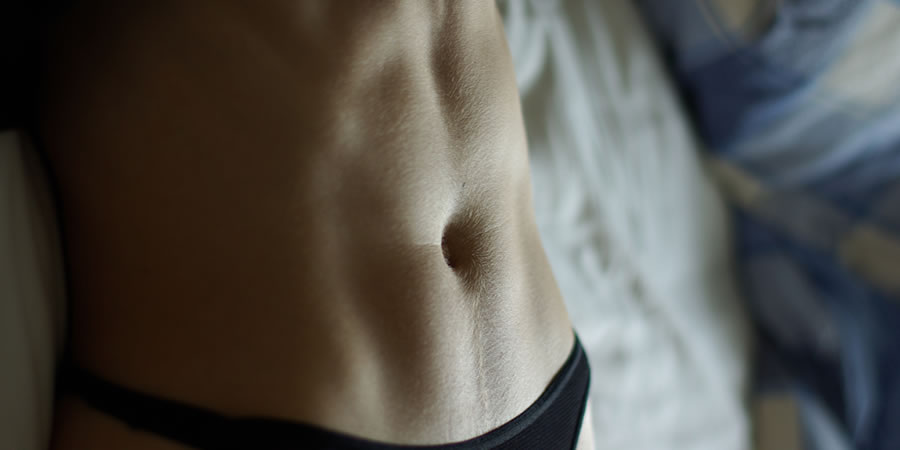“Pull in the abs!” A little phrase that might be called a Pilates chant, yet it is so misunderstood.
Pulling the abdominals in is fundamental to the Pilates method of exercise. It is a technique that is promoted in physical therapy settings, in strength training, and to some degree throughout the fitness world as a means of stabilizing the spine.
Done properly, training the abdominals will create an integrated core of strength that supports the spine and facilitates stability and freedom of motion throughout the body. What is it to “pull in the abs” effectively, and how is it different from the destabilizing “suck in the middle” approach that shows up in many fitness scenarios?
In Pilates, we are looking to create a strong, stable foundation for movement. We develop this powerhouse for movement by employing the muscles of the pelvic floor and all of the abdominal muscles, teaching them to work efficiently and in harmony with the muscles of the back.
Pilates puts a special emphasis on training the deeper abdominal muscles, such as the transversus abdominis. These muscles are often underdeveloped and not working equally with the oft overworked surface muscles, such as the famous rectus abdominus (the six pack abs muscle).
Images like “pull your belly button to your spine,” or worse, “pretend you got punched in the stomach” are often used to encourage a deep pull-in of the abs. These images, while they do convey the look of pulled in abs, can be misleading. They put the emphasis of the pull-in at the waist and may encourage a destabilizing forward slump of the upper torso along with a tuck of the pelvis. The inner mechanics of creating a stable core begin not at the belly button, but with engaging the muscles of the pelvic floor.
Use the Pelvic Floor
Working the pelvic floor muscles is not just for women or bouncing back from pregnancy. The engagement of the muscles of the pelvic floor is critical to providing a stable base of movement for anyone. You feel like you are pulling the pelvic floor up and in toward the center line. One might also imagine pulling the sit bones together. This is similar to Kegel exercises. The only real difference is in intensity. In Kegels, one is entirely focused on the pelvic floor, and the pull up may be more aggressive and sustained than what you would use for general exercise.

Pull In and Scoop the Abdominals
After the pelvic floor is engaged, the actual pull-in begins just above the pubic bone and becomes a deep pull-in of the lower abdominals. From there, the pull-in action progresses upwards to pulling the belly button to the spine, and then the upper abdominal area. From there, some people find that they can get an extra upward lift of the abdominals; this is a true scoop of the abs. These moves are not as obviously sequential as they may sound, but a bottom to top awareness is the best way to practice engaging the abdominal muscles properly. Note: The pull-in is not just from front to back, but also from the sides of the trunk.
A Strong Back Works With the Abs
Pulling the abs in is usually done with a neutral spine. That means that the natural curves of the spine are present and the pull-in does not create a forward flexion of the upper spine or a tuck of the pelvis. As the abdominals pull in, it is essential to maintain both length and breadth in the back as the muscles are challenged to counter the pull of abdominals. Pilates does use both forward flexion and a flat or curved (see finding your C-curve) lower back for many exercises in Pilates, but those are choices that are made for specific exercise intentions beyond the initial pulling in of the abs. In general, a neutral spine is the strongest position and what we want for effective everyday movement.
How to Breathe in Abdominal Work
A question that comes up a lot for people who are learning to pull their abdominals in is, “If I have everything so pulled in, how do I breathe?” The answer is that we usually use a very small amount of our breathing capacity and tend to focus on the front body. In Pilates, we use lateral breathing to allow the breath to fully expand into the sides and down the back of the body. Doing so provides a lot of breathing room, and helps open and lengthen the back of the body as well.
When to Pull in the Abdominals
In Pilates and many other exercise systems, the abdominal pull-in can be used quite intensely as a training tool. The idea is that the muscles will become stronger, and their interactivity better organized so that everyday movement, or even athletic movement, is easily supported. The intention is not to imply that the intense pull-in is an ideal that would be in action all the time. As one develops a stronger core, the muscles become more toned and ready for action. But there is no need to try to pull your abs in all day.
Integrating the Abdominal Workout
Pulling in the abdominals is just part of the set up for developing strength and efficient motion in Pilates. We are always looking at the whole picture wherein the alignment of all body parts, the full utilization of the breath, and the application of focused awareness are integral to achieving the full benefits of each exercise. Read more about Pilates integrative approach to exercise and the six Pilates principles.
Source: https://www.verywellfit.com/pulling-in-the-abdominals-2704435








